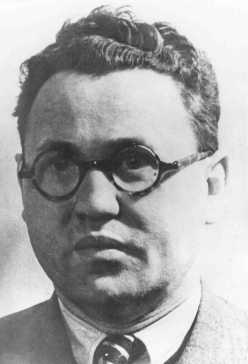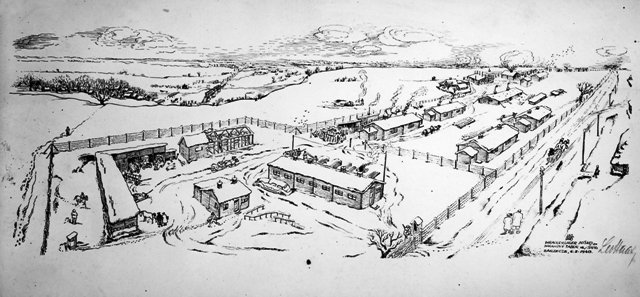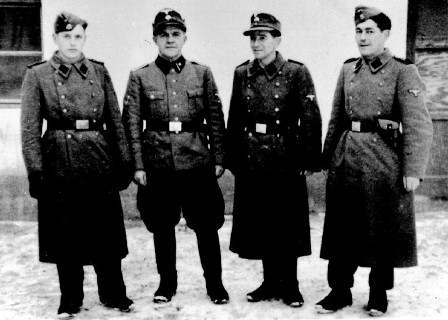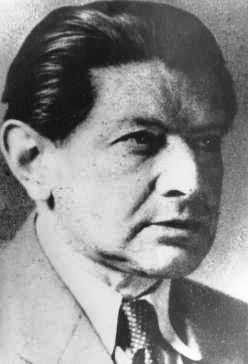Holocaust Education & Archive Research Team |
Ghettos
Introduction to the Ghettos of the Holocaust
Jewish Ghettos The Judenrat Judenrat Leaders Prominent Jews
| ||
Jacob Edelstein
Jacob Edelstein was born in Gorodenka, Galicia and received a religious Zionist upbringing, during World War One his family moved to Brno, the capital of Moravia, and from 1926 he was active in the Tekhelet – Lavan and He- Haluts Zionist youth movements.
In 1929 he was elected Tekhelet – Lavan representative at the He-Haluts main office, and in 1933 he was appointed head of its Palestine Office in Prague.
In the summer of 1937 Edelstein immigrated to Palestine and for three months worked there for Keren Hayesod (The Palestine Foundation Fund) but he was disappointed with that situation and decided to return to Prague, where he resumed his work as director of the Palestine Office.
On March 15 1939, the day the Germans marched into Prague, the members of the Zionist leadership of Czechoslovakia held a meeting at which they decided that it was their duty to stay on and not abandon the Jewish population at a time of crisis.
Edelstein became the leading personality in the Zionist leadership, was put in charge of emigration to Palestine, and before long became the official representative of the Jews in contacts with the Germans.
Until he was sent to Theresienstadt, the so – called “Paradise Ghetto” on the 4 December 1941, Edelstein left the country for several trips abroad, with the Gestapo’s permission, in order to look for ways and means to speed up the emigration of Jews.
In May 1939 he again visited Palestine and in November he was in Trieste and at the end of the same month he was in Vienna and in February 1940 he spent two days in Geneva and from there went to the capital of the Reich Berlin.
Edelstein visited Bratislava in the autumn of 1940, and in March 1941 he went to Amsterdam, in each of these places he met with the Jewish community leaders and the Zionist leadership, sharing his information and experiences with them, and he warned them of possible future developments. He had several opportunities to stay abroad rather than return to Czechoslovakia, but he always went back to Prague.
On the 18 October 1939, Edelstein with a group of a thousand men from Moravska Ostrava left for Nisko, on the San River, south of Lublin, Poland, in connection with the German plan for the resettlement of Jews in the Lublin district. This plan ended in failure, and some of the deportees were returned to their place of origin.
Edelstein returned to Prague in November 1939, his experiences in Nisko gave him first hand knowledge of the conditions in the East and what was taking place there. He decided to do everything in his power to ensure that the Jews of Czechoslovakia would not be deported to Poland, since he doubted whether they could survive in the harsh conditions prevailing in German occupied Poland.
It was now his major concern to persuade the Germans to let the Jews stay in the Protectorate of Bohemia and Moravia and to utilise them as manpower. Jewish labour as a means of saving Jewish lives became the core of Edelstein’s policy and this prompted him time and again to make proposals for the German exploitation of Jewish manpower.
In October 1941 the Germans decided on the establishment of the Theresienstadt ghetto as a temporary solution for the Jews of the Protectorate and a base for their future deportation to the East. The Jewish leadership, with Edelstein at its head, saw in the founding of Theresienstadt a personal achievement and the success of their efforts to obtain permission for the Jews to stay in the Protectorate. They did not know that Theresienstadt was only a temporary arrangement.
Jacob Edelstein arrived in Theresienstadt on the 4 December 1941 and became the first chairman of the ghetto’s Judenrat. He was assisted by a deputy Otto Zucker, and a council of twelve.
The emphasis in the ghetto was on education of the young and on making the ghetto into a productive establishment. Edelstein believed that Terezin (Theresienstadt) could be used as a kind of Hachshara - preparation for young Jews to make Aliyah - moving to Israel after the war. He held that position from 4 December 1941 until January 1943. Eichmann replaced him with Paul Eppstein because Edelstein was accused of having corrupted transportation lists.
However, Edelstein remained on as first deputy and Rabbi Benjamin Murmelstein as second deputy to Eppstein. In January 1943 Edelstein was dismissed from his post, on the charge that there was a discrepancy between the registered population of the Theresienstadt ghetto and the actual figure.
On the 18 December 1943 he was deported to Auschwitz with his family, Jacob Edelstein was imprisoned in Block 11 with his closest associates. On February 1944 Adolf Eichmann, visited the Theresienstadt Family Camp, and he spoke to Miriam Edelstein informing her that “her husband is probably in Germany.”
On the 20 June 1944 Jacob Edelstein and his family and associates were shot and killed in the Crematorium III in Birkenau.
Edelstein’s activities in Theresienstadt have been the subject of much dispute, some who find fault with him charge him with cooperating with the Nazis and with misreading the situation. His policies have been criticised, but not his personal integrity and honesty, whilst others regard Edelstein as a hero, who sacrificed himself for the sake of the Jewish race.
Sources:
Encyclopaedia of the Holocaust The Holocaust, by Sir Martin Gilbert, published by Collins London 1986 Auschwitz Chronicle by Danuta Czech published by Henry Holt and Company New York Wiener Library Yad Vashem – Resource Centre
Copyright: Stefan Lundberg H.E.A.R.T 2010
|



